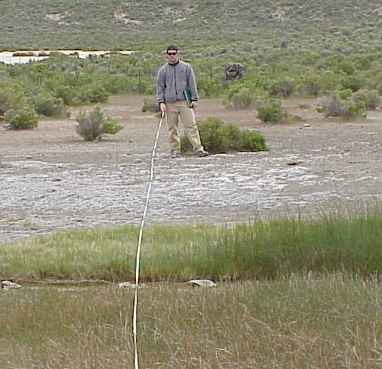
Andrew runs a transect at Borax Lake. Note the lack of plant diversity!
The objectives of the Plant Ecology group were to assess the plant community in a randomly-distributed quadrant, measure light intensity, temperature and soil type.

Andrew runs a transect at Borax Lake. Note the lack of plant diversity!
Mickey Hot Springs
| LOCATION | SOIL TYPE | PLANT DIVERSITY/DISTIBUTION | COMMENTS |
| Large Upper Spring | Small rocks | Spring Edge: Green grass
@ 7 meters: 14 tufts of grass @ 15 meters: 1 rabbitbrush |
Sparse vegitation; Light intensity high |
| Lower Spring Area | Fine soil, sand and silt | @ 5-10 meters: Grass types are dominant; possibly Tall and Short Rye
@12-15 meters: Grass sparser in small tufts @15-30 meters: 1 rabbitbrush |
Plant diversity is higher. Evidence of rodents, spiders and cockroaches, mostly found dead in or around spring |
| Adjacent Spring | Fine soil, sand and silt | Same as above | Same as above |
Borax Lake was the first site we obtained samples. We ran a transect of 30 meters from the lake's edge and identified all the plants underneath the line. The most common variety of plants we came across were grasses, and occasionally what used to be a small shrub. We ran a second transect to see if we could find any different flora species but grass seemed to have the biggest foothold. One hypothesis was that the soil was the reason why grasses seemed to do so much better than anything else. Since Borax Lake is a very active geothermal area, the concentration of minerals in the soil would be much higher than the average plot of soil further from the lake. This could mean a few things; the grasses could favor the mineral content more than most other plant species, enabling them to establish a better foothold in a shorter amount of time. Another hypothesis is that grasses, growing faster than the other plants, would out-compete other species for available light.
Our second stop, at Alvord Bathhouse Springs, produced much the same results found at Borax Lake. Only grasses were found, likely because the soil was heavily saturated from the spring. Plants with bigger root systems would not have been able to support the rest of the plant; if they did not topple over first, the roots would have drowned. We had much the same hypothesis at this site, because it did not differ substantially from Borax Lake. In both locations, the main issue is how well a plant can grow in a mineral rich environment. Grasses seem to be the only ones capable of doing that. Once the grasses reached a good height (approximately a foot or so), they would pretty much drive out the rest of the competition for sunlight and grow almost without any restrictions.
Mickey Hot Springs contained the most plant diversity out of all the sites we visited. Besides grasses, there were actual green plants not found at either of the other site we went to. There were two pools at Mickey Hot Springs, one at slightly a higher elevation than the lower one. Thewater was hotter by almost 20 degrees Celsius at the lower pool. Steam seemed to be the major factor in the much broader diversity of flora at this site. All monocots and dicots have tiny openings underneath their leaves called stomata, which are used for gas exchange. When the stomata open, they release oxygen into the air along with some water. As carbon dioxide rushes into the now empty space, some water molecules can creep in as well and give the plant some extra nourishment. A more realistic hypothesis still involves the steam as the major contributor, but as the steam blows in between the plants, some of the water vapor condenses on the plant's epidermis and drips into the soil and reaches the plant's roots. It is possible that some plants have adapted features where specialized cells that exist on the epidermis exclusively draw in water from the outside environment. The transect we ran was a lot more interesting than the first two stops, but the reason why we think that the steam is strictly responsible for the increased number of plant species is because at about 2 meters away from the spring itself, the lush vegetation does not grow.
As for the previous hypotheses about the soil being one of the major factors as to why the grass has dominated the landscape, I believe that the abiotic components that make up the mineral content of the soil is not drastically different between each site. The presence of moss could have been one of the primary producers in an ecological succession that made the habitat more suitable for other plant species to live. In other words, the mosses could have thrived on the high mineral content and started to grow and reproduce. The products that they leave behind will make the habitat suitable for yet another species of plant, which in turn will create conditions for another and so on.